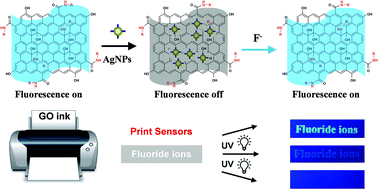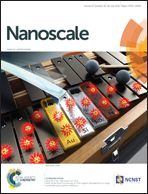Fluorescence and visual detection of fluoride ions using a photoluminescent graphene oxide paper sensor†
Abstract
The instant and on-site detection of trace aqueous fluoride ions is still a challenge for environmental monitoring and protection. This work demonstrates a new analytical method and its utility of a paper sensor for visual detection of F− on the basis of the fluorescence resonance energy transfer (FRET) between photoluminescent graphene oxide (GO) and silver nanoparticles (AgNPs) through the formation of cyclic esters between phenylborinic acid and diol. The fluorescence of GO was quenched by the AgNPs, and trace F− can recover the fluorescence of the quenched photoluminescent GO. The increase in fluorescence intensity is proportional to the concentration of F− in the range of 0.05–0.55 nM, along with a limit of detection (LOD) as low as 9.07 pM. Following the sensing mechanism, a paper-based sensor for the visual detection of aqueous F− has been successfully developed. The paper sensor showed high sensitivity for aqueous F−, and the LOD could reach as low as 0.1 μM as observed by the naked eye. The very simple and effective strategy reported here could be extended to the visual detection of a wide range of analytes in the environment by the construction of highly efficient FRET nanoprobes.


 Please wait while we load your content...
Please wait while we load your content...